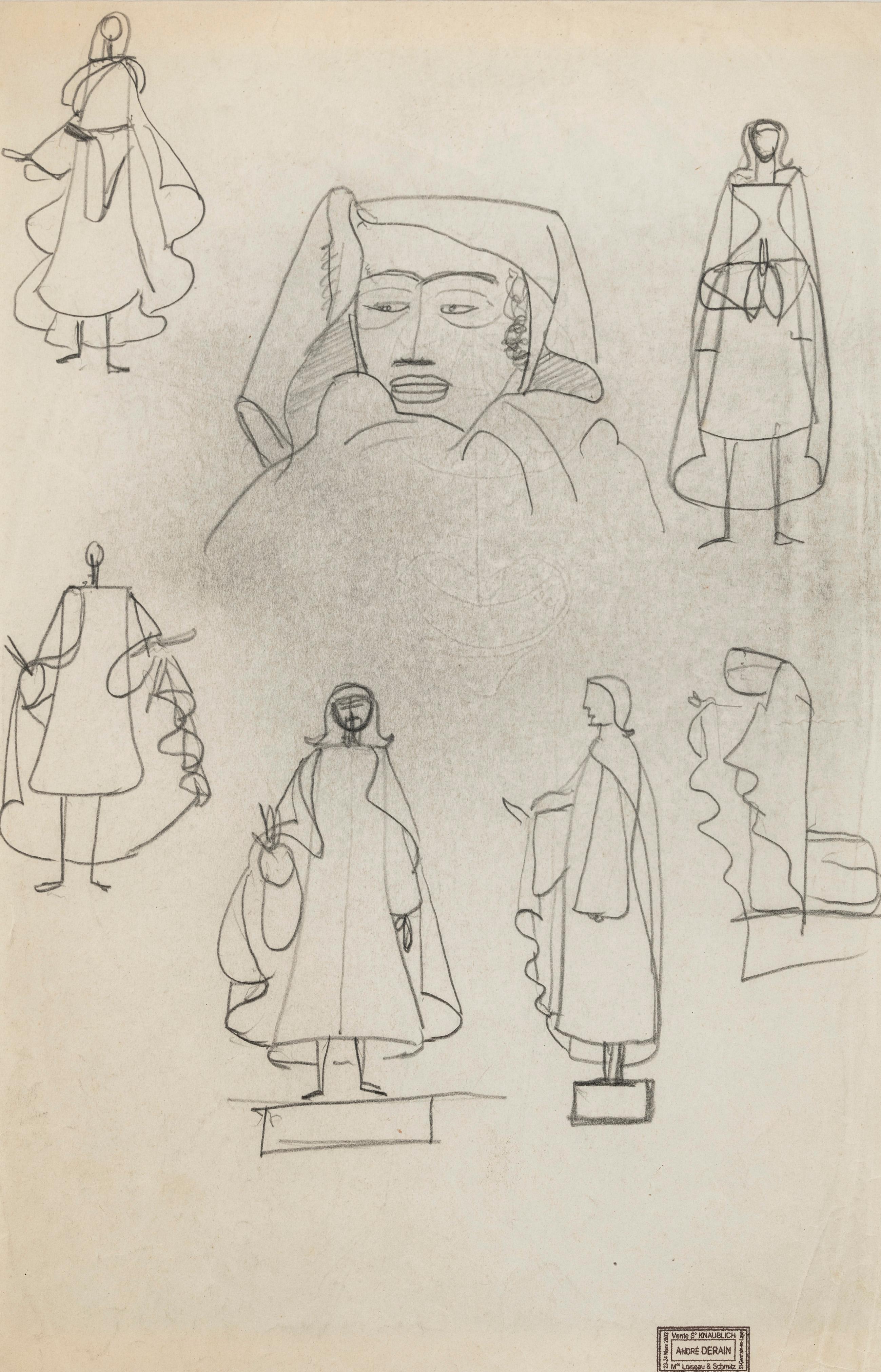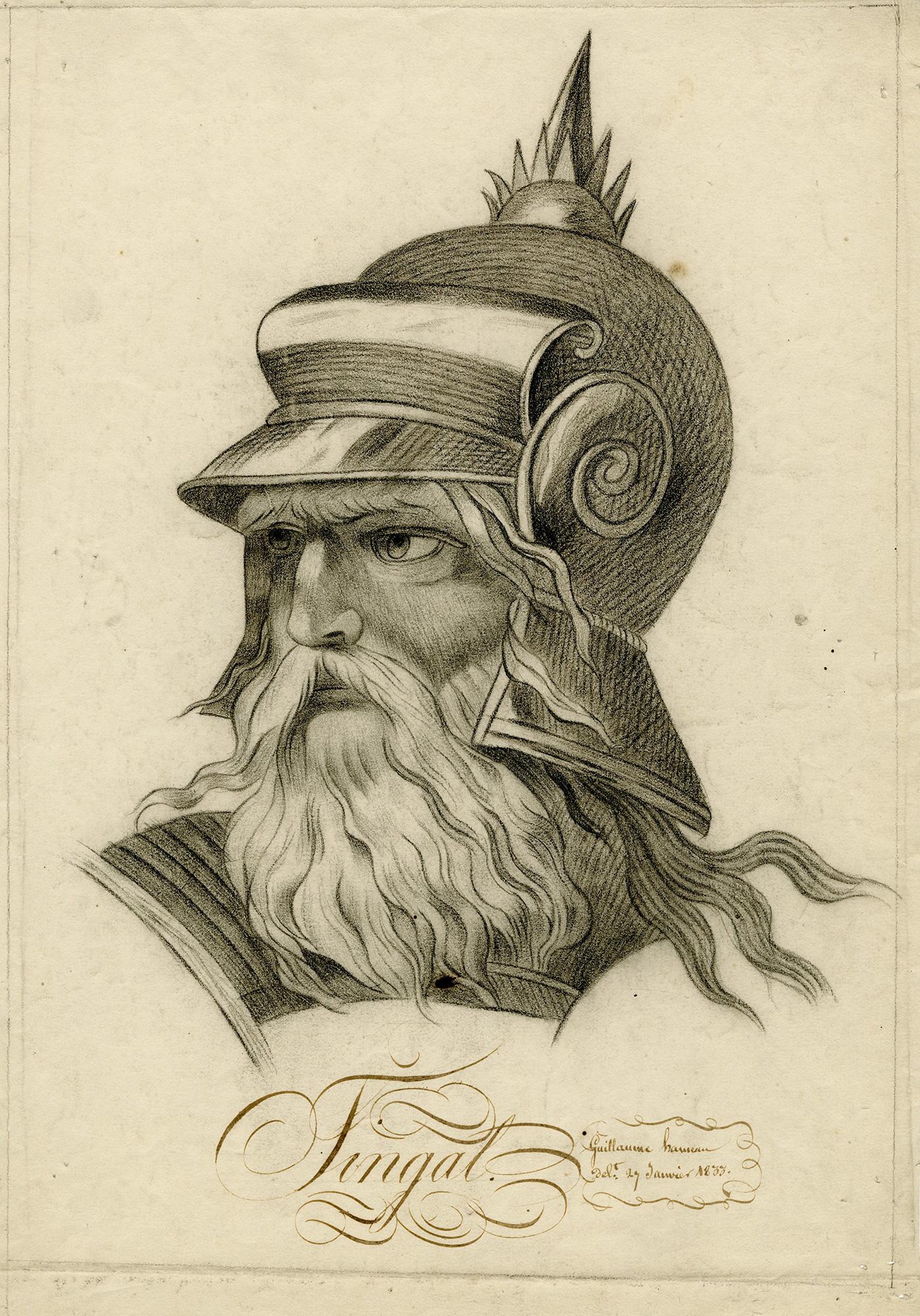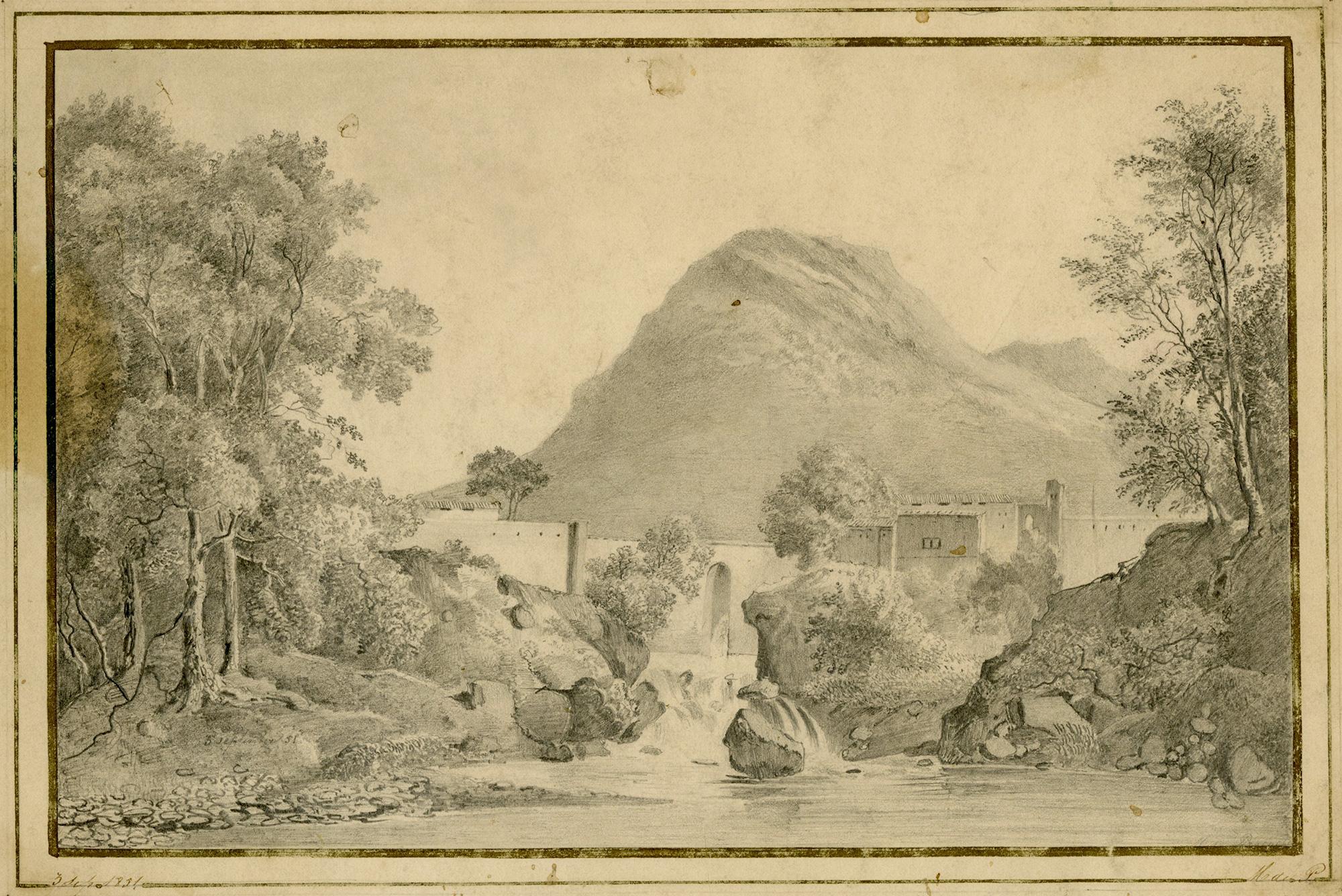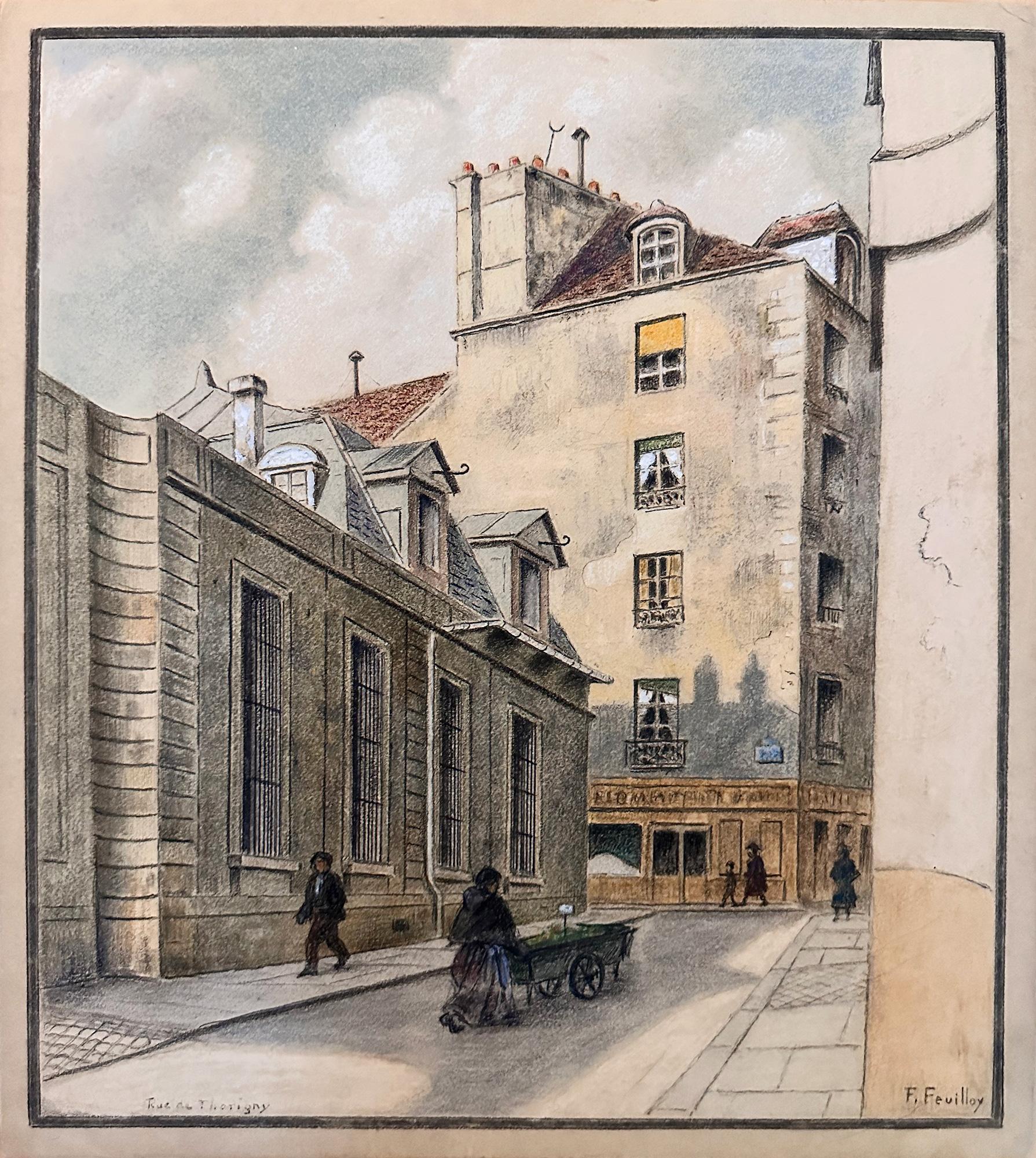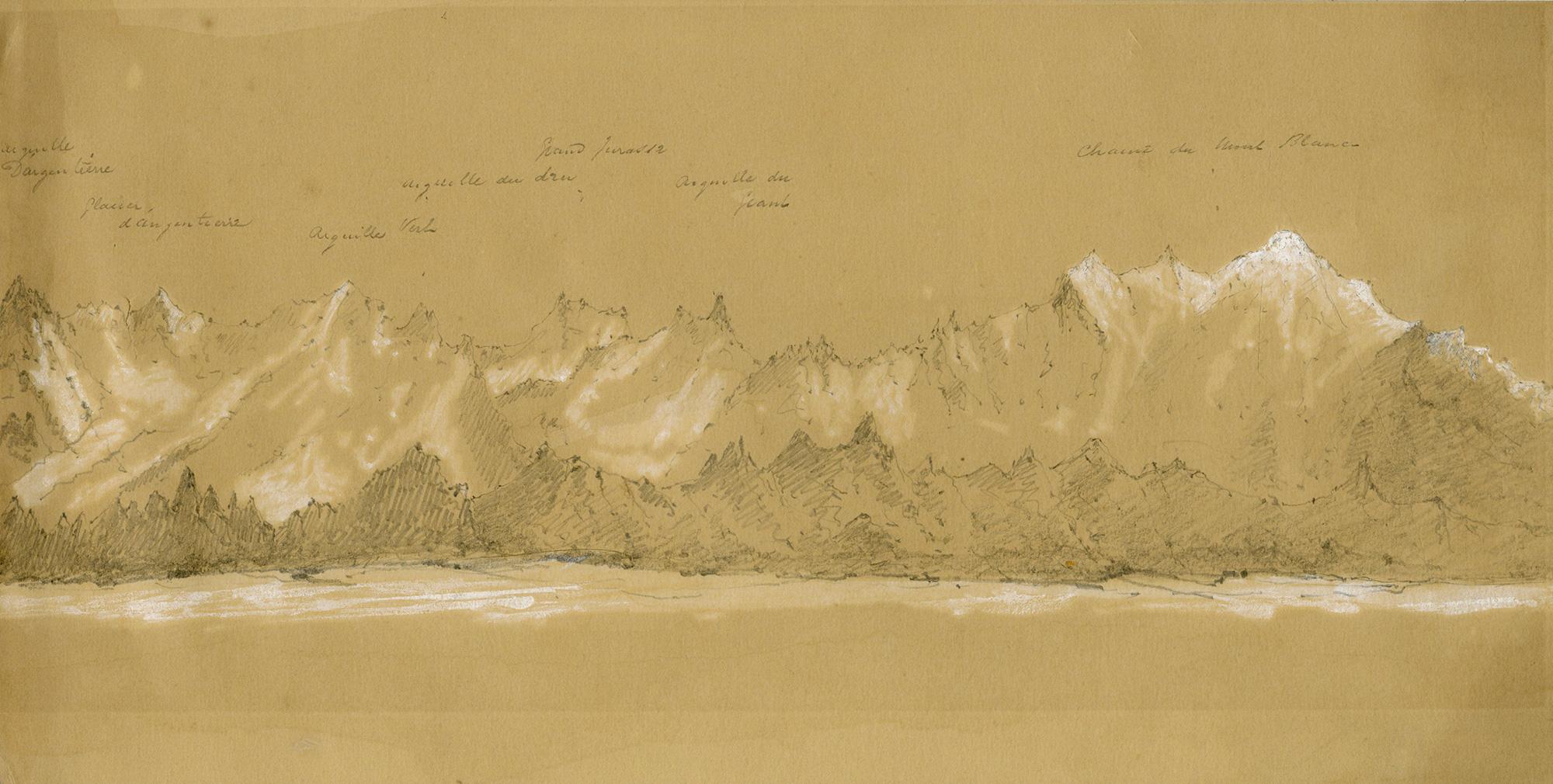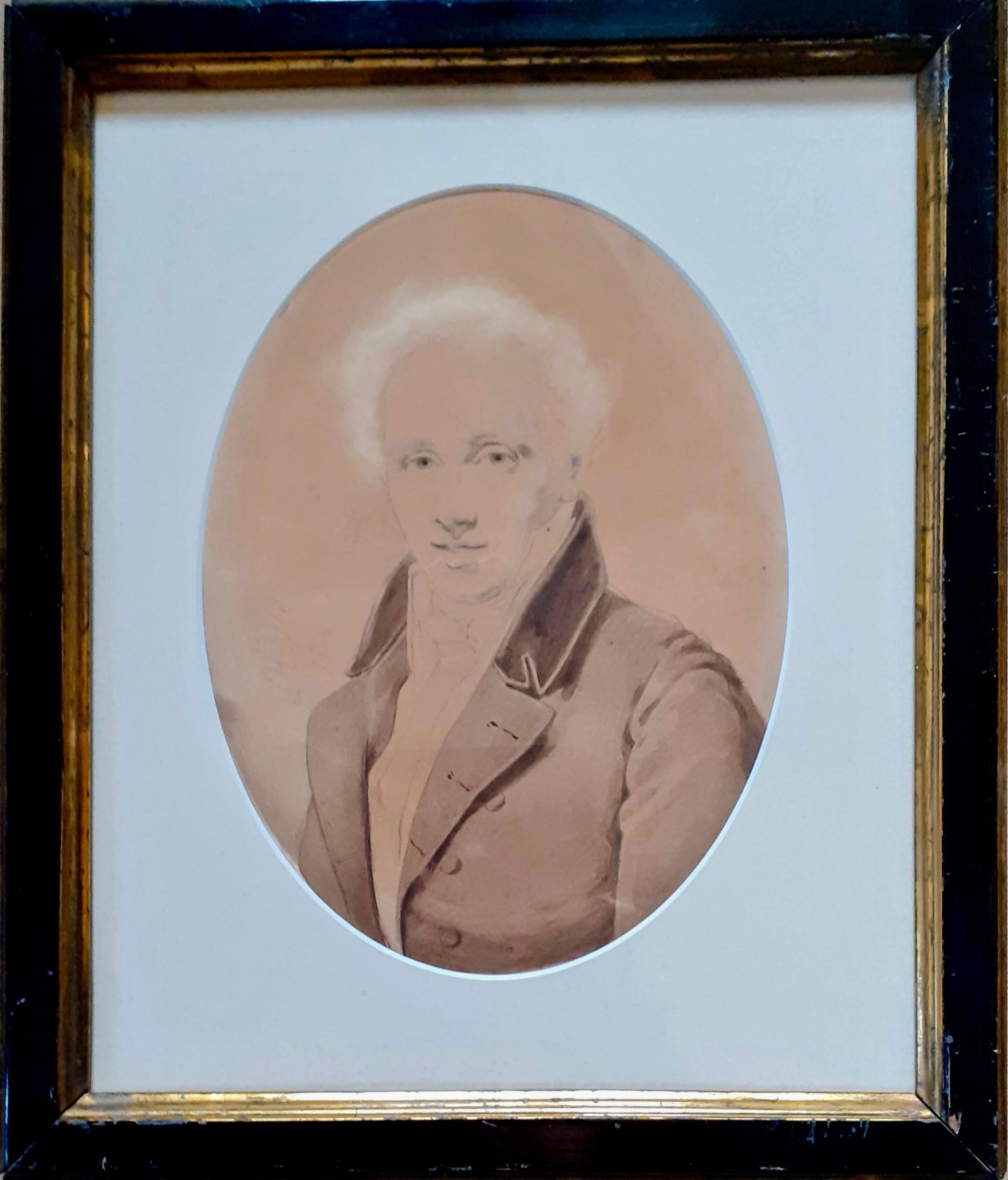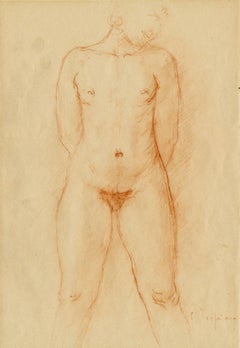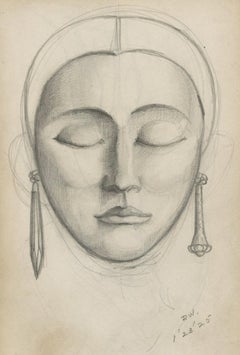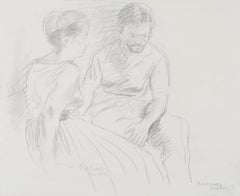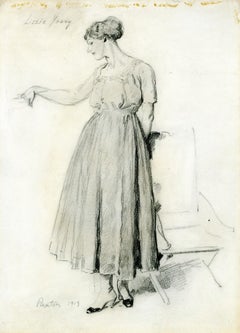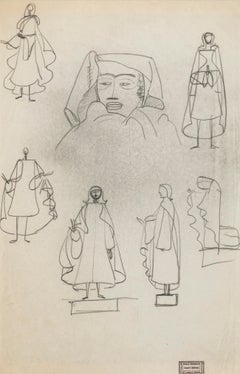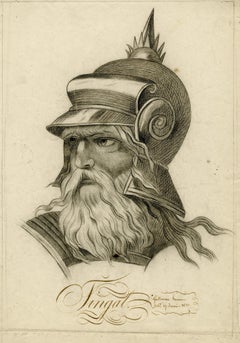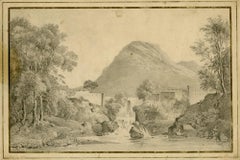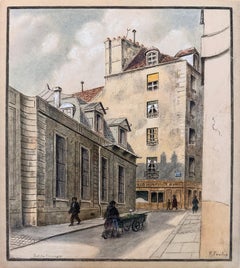Articoli simili a Untitled (Standing man with umbrella behind)
Vuoi altre immagini o video?
Richiedi altre immagini o video al venditore
1 di 5
Charles MaurinUntitled (Standing man with umbrella behind)c. 1890
c. 1890
Informazioni sull’articolo
Untitled (Standing man with umbrella behind)
Graphite on paper, c. 1890's
Unsigned
Provenance: Estate of the Artist
Lucien Goldschmidt (1912-1992), noted art
dealer and scholar on Maurin
From the artist's sketchbook/record book, with the typeface number "561"
Image size: 7 7/8 x 6 1/4 inches
Condition: Good, tipped to support sheet
Charles Maurin
le puy-en-velay 1856 - grasse 1914
Biography
Having won the art scholarship known as the Prix Crozatier in 1875, Charles Maurin entered the Ecole des Beaux-Arts in Paris, studying with Jules Lefèbvre and Gustave Boulanger, and with Rodolphe Julian at the Académie Julian. He first exhibited at the Salon des Artistes Français in 1882, where he showed a pair of portraits, one of which gained an honourable mention. He continued to exhibit at the Salon des Artistes Français until 1890. He participated in the Salon des Indépendants for the first time in 1887, showing a number of paintings, drawings and engravings that were admired by, among others, Edgar Degas. As an artist, he worked in a variety of styles, the most distinctive being a sort of Symbolism evident in a range of allegorical subjects that he treated.
Maurin had a lifelong interest in the depiction of the female nude, and, like Degas and Mary Cassatt, was fond of portraying women at intimate moments of their daily routine. He also produced a handful of splendid portraits, mainly in the 1880s and 1890s, of friends, patrons and fellow artists including Georges Seurat and Rupert Carabin, as well as drawings and pastels of café, theatre and street scenes. Around 1885 he took up an appointment as a professor at the Académie Julian, where he met Félix Vallotton, who became a close friend. Another good friend was Henri de Toulouse-Lautrec, with whom Maurin shared an exhibition in 1893 at the Galerie Boussod et Valadon in Paris. It was there that, at the urging of Degas, the collector Henry Laurent began to acquire Maurin’s work, eventually becoming his foremost patron and collector.
The 1890s found Maurin enjoying a moderately successful career, with one-man shows with Ambroise Vollard in 1895 and at Edmond Sagot in 1899. He received a commission from the State for a painting of Maternité (Motherhood); completed in 1893 and sent to the museum in his native town of Le Puy, the painting was soon regarded as one of the artist’s finest works. The previous year he took part in the inaugural Salon de la Rose + Croix, where he showed one of his largest and most important paintings; a monumental triptych entitled L’Aurore (Dawn). He also contributed works to the Salons de la Rose + Croix of 1895 and 1897. Maurin painted a series of large decorative panels of Tragedy, Dance and Music for the foyer of the municipal theatre in Le Puy in 1893, and for Sarah Bernhardt designed sets and costumes for Edmond Rostand’s La Princess Lointaine in 1895. He visited Holland, Belgium and England, and sent works to Le Libre Esthétique in Brussels in 1896 and 1897, and the Exhibition of International Art in London in 1898. A man of firm anarchist leanings, Maurin produced illustrations for the radical journal Le Temps nouveau, and published portrait prints of the French anarchists Louise Michel and François Koenigstein, known as Ravachol. In 1895 he was also commissioned to provide illustrations for the art and literary journal La Revue Blanche.
After 1900, however, Maurin’s output declined considerably, partly due to ill health, and the last years of his life were spent in Brittany and Provence, where he died in obscurity in 1914. His work was largely forgotten after his death, although a retrospective exhibition was held at the Galerie Bernheim-Jeune in Paris in 1921, while a monograph on his work by Ulysse Rouchon was published the following year. Although a significant collection of Maurin’s work is today in the collection of the Musée Crozatier in Le Puy-en-Velay, his paintings and drawings remain little represented in museums outside France.
As a draughtsman, Charles Maurin was equally adept in pastel, chalk and pencil, and was highly regarded by critics, collectors and fellow artists; his drawings were, for example, particularly esteemed by Degas, who compared his draughtsmanship to that of his own great hero, Ingres. An innovative artist, he invented a method of using an atomizer to spray pigment onto the surface of the paper to create what he termed ‘peintures au vaporisateur’; large, atmospheric watercolour landscapes of great subtlety and beauty. Maurin is perhaps best known today, however, as a gifted and prolific printmaker, and played an important role in the revival of colour etching and wood engraving in the 1890s. Like his paintings, many of his prints focus on the female nude, or the theme of mothers and children, and account for some of the artist’s most striking and individual works. Maurin also developed a number of new techniques and processes, particularly with regard to printing in colour. Some of his prints were published in editions of ten or less, however, and much of his graphic work remains very rare today.
Although long forgotten or ignored after his death, Charles Maurin’s eclectic oeuvre as a painter, printmaker and draughtsman remains one of the most distinctive of any artist in France in the late 19th century. The French scholar Jacques Foucart, writing in 1979, succinctly described the artist as ‘that curious and libertarian figure, so typical of the effervescent Paris of the Belle Epoque, an engraver of social customs comparable with Louis Legrand, a perfectionist and an inventive technician, a sensitive draughtsman à la Besnard, a friend of Lautrec and Valloton. He created some of the most extravagant humanitarian and ‘socialist’ visions of the fin-de-siècle, which he treated in a flexible and decorative ‘graphisme’ in the manner of Eugène Grasset, or even of De Feure...That an artist of such intriguing qualities – even though, as engraver of nudes, he does at times become rather tiresomely vulgar and commercial – and so representative of a period that was hungry to explore everything (it is often said that all modern art was contained in the years before 1914), has been the subject of neither an exhibition, since that of 1921 at Bernheim’s, nor of a monograph, certainly sets one thinking about the vagaries of Taste and about the nature of the present fashion for the art of 1900.’ In recent years, however, a revival of interest in Maurin’s remarkable body of work culminated in a major monographic exhibition, entitled Charles Maurin, un Symboliste du Réel, at the Musée Crozatier in the artist’s native town of Le Puy-en-Valey in 2006.
Courtesy Stephen Ongpin, London
- Creatore:Charles Maurin (1856 - 1914, Francese)
- Anno di creazione:c. 1890
- Dimensioni:Altezza: 20,02 cm (7,88 in)Larghezza: 15,88 cm (6,25 in)
- Tecnica:
- Movimento e stile:
- Periodo:
- Condizioni:
- Località della galleria:Fairlawn, OH
- Numero di riferimento:Venditore: FA122631stDibs: LU14016413012
Informazioni sul venditore
5,0
Venditore riconosciuto
Questi venditori prestigiosi sono leader del settore e rappresentano il massimo in termini di qualità e design.
Venditore Oro
Venditori Premium con valutazione 4,3+ e tempi di risposta entro 24 ore
Fondazione nel 1978
Venditore 1stDibs dal 2013
789 vendite su 1stDibs
Tempo di risposta standard: <1 ora
Associazioni
International Fine Print Dealers Association
- SpedizioneRecupero del preventivo…Spedizione da: Akron, OH
- Politica di reso
Alcune parti di questa pagina sono state tradotte automaticamente. 1stDibs non può garantire che le traduzioni siano corrette. L’inglese è la lingua predefinita del sito.
Garanzia di autenticità
Nell’improbabile caso in cui si verifichi un problema con l’autenticità di un articolo, contattaci entro un anno per ottenere un rimborso completo. DettagliGaranzia di rimborso
Se il tuo articolo non corrisponde alla descrizione, è danneggiato durante il trasporto o non arriva, contattaci entro 7 giorni per un rimborso completo. DettagliAnnullamento entro 24 ore
Hai un periodo di tolleranza di 24 ore per annullare il tuo acquisto, senza necessità di fornire spiegazioni.Venditori professionali selezionati
I nostri venditori di livello internazionale devono aderire a rigorosi standard di servizio e qualità, garantendo l’integrità delle inserzioni.Garanzia miglior prezzo
Se scopri che un venditore ha pubblicato altrove lo stesso articolo a un prezzo più basso, applicheremo lo stesso prezzo.Consegna globale affidabile
La nostra rete di vettori leader del settore offre opzioni di spedizione specializzate in tutto il mondo, inclusa la consegna personalizzata.Altro da questo venditore
Mostra tuttoNu (Nudo femminile in piedi)
Di Charles Despiau
Nu (Nudo femminile in piedi)
Gesso rosso su carta ondulata, 1925 ca.
Firmato in basso a destra dall'artista, vedi foto
Condizioni: Eccellente
Dimensioni dell'immagine/foglio: 12 1/8...
Categoria
Anni 1920, Scuola francese, Disegni e acquarelli (nudo)
Materiali
Gesso
Testa di donna deco (recto) Modello maschile in piedi (verso)
Di Paul H. Winchell
Testa di donna deco (recto) Modello maschile in piedi (verso)
Grafite su carta, 1925
Firmato con le iniziali dell'artista "PW" e datato 1925.
Creato mentre l'artista studiava all'A...
Categoria
Anni 1920, Art Déco, Disegni e acquarelli figurativi
Materiali
Grafite
Coppia seduta
Di Raphael Soyer
Ispirazione (Coppia seduta)
Grafite su carta, 1967 circa
Firmato due volte a matita dall'artista sul recto (vedi foto)
Condizioni: Eccellente
Dimensioni dell'immagine: 13 x 16 pollic...
Categoria
Anni 1960, American Modern, Disegni e acquarelli figurativi
Materiali
Grafite
1.950 USD
Studio preliminare per il dipinto Rose and Gold, 1913
Di William McGregor Paxton
Studio preliminare per il dipinto Rose and Gold, 1913
Grafite su carta, 1913
Firmato a matita in basso a sinistra (vedi foto)
Titolato "Lizzy Young" a matita in alto a sinistra (vedi...
Categoria
Anni 1910, Impressionismo americano, Disegni e acquarelli figurativi
Materiali
Grafite
Studio preliminare per la scultura in bronzo della Danzatrice cretese
Di Boris Lovet-Lorski
Studio preliminare per la scultura in bronzo della Danzatrice cretese
Senza segno
Grafite su carta da lucido, 1930-1934
Dimensioni del foglio: 6 7/8 x 7 1/8 pollici
Creato mentre l'a...
Categoria
Anni 1930, Art Déco, Disegni e acquarelli figurativi
Materiali
Grafite
Senza titolo (Letitia, incinta di Rising Sun)
Di Sedrick Huckaby
Senza titolo (Letitia, incinta di Rising Sun)
Grafite su carta, 2005
Firmato: "Sedrick Huckaby III" in basso a destra (vedi foto)
Nell'aprile 2008, Huckaby ha ricevuto una borsa di s...
Categoria
Inizio anni 2000, Contemporaneo, Disegni e acquarelli figurativi
Materiali
Grafite
Ti potrebbe interessare anche
Schizzi di figure maschili e Silhouette
Di André Derain
Opera bifacciale in buone condizioni, dispersione della successione di Knaublich, Loiseau-Shmitz, 23/03/2002. Tampone "Atelier Derain" in basso a destra. Mostre:Talismans VI, galerie...
Categoria
Anni 1940, Scuola francese, Disegni e acquarelli figurativi
Materiali
Carta, Grafite
Ritratto di Fingal / Finn MacCool - Il commovente ritratto di un eroe letterario irlandese
Gesso nero e grafite su carta leggera color crema, 16 1/8 x 11 1/4 pollici (410 x 286 mm), il foglio intero. Firmato, intitolato e datato con inchiostro seppia nell'area del foglio i...
Categoria
Inizio XIX secolo, Scuola francese, Disegni e acquarelli (ritratto)
Materiali
Carta fatta a mano, Gesso, Grafite
Paesaggio montano con acquedotto e diga - SCUOLA FRANCESE
Matita su carta liscia color crema con il vetro di una finestra disegnato con inchiostro dorato, 8 3/8 x 11 3/4 pollici (213 x 298 mm). Firmato in modo illeggibile e datato a inchios...
Categoria
Metà XIX secolo, Scuola francese, Disegni e acquarelli (paesaggio)
Materiali
Oro
Rue de Thorigny, firmato F. Feuilloy
Grafite e pastello a colori con sfumature in bianco su carta ondulata color crema, 13 1/2 x 12 1/4 pollici (343 x 310 mm) (foglio). In buone condizioni, con tonalità uniformi, pieghe...
Categoria
Fine XIX secolo, Scuola francese, Disegni e acquarelli (paesaggio)
Materiali
Pastelli, Carta fatta a mano, Grafite
Chaîne de Aravais (Montagne delle Alpi) - Scuola francese, disegno, 1850 ca.
Un bellissimo disegno della catena montuosa degli Aravis nelle Alpi, compreso il Mont Blanc, con tutte le cime identificate a mano.
Circa 1850
Grafite con sfumature bianche su carton...
Categoria
Metà XIX secolo, Scuola francese, Disegni e acquarelli (paesaggio)
Materiali
Cartone, Matita colorata, Grafite
Ritratto di un gentiluomo con una redingote, disegno dell'allievo Jean Louis David
Un eccezionale ritratto a inchiostro, lava e grafite di un gentiluomo di Henri-Joseph Hesse, risalente al 1820 circa, all'epoca della restaurazione borbonica in Francia. Raffigura un...
Categoria
Inizio XIX secolo, Scuola francese, Disegni e acquarelli (ritratto)
Materiali
Carta, Inchiostro, Grafite
